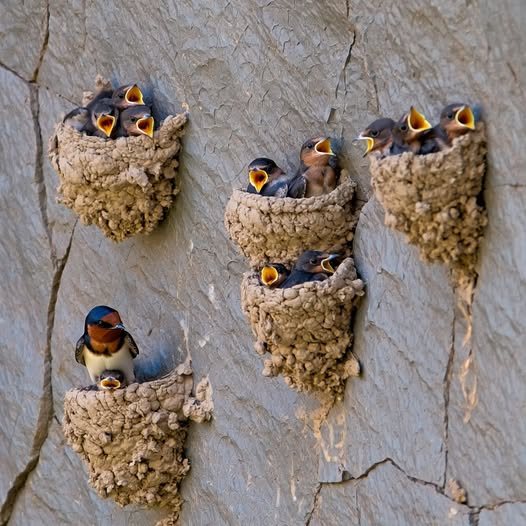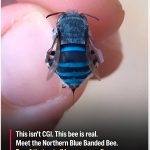The Sky Architects: How Cliff Swallows Build Cities of Mud and Memory

The Sky Architects: How Cliff Swallows Build Cities of Mud and Memory
At first glance, the Cliff Swallow (Petrochelidon pyrrhonota) might seem like just another small, swift-flying bird, a blur of motion against the sky. But to look closer—really look—is to uncover one of the most astonishing architects in the natural world. Each spring, from highways to canyon walls, these birds build vast, bustling colonies, weaving together communities of mud and instinct that resemble miniature cities clinging to vertical surfaces.
Their tools? Not steel or stone—but tiny pellets of mud. Thousands of them, shaped and stacked with extraordinary precision. With their shimmering cobalt backs and creamy underbellies, Cliff Swallows don’t just survive—they engineer. And every year, they return—often to the exact site of last season’s home—as if pulled not only by instinct but by memory, tradition, and something very close to loyalty.

This is the story of a bird that builds not just nests, but neighborhoods. A creature so small, yet so ambitious, it reshapes entire walls with nothing but determination, teamwork, and a beak full of wet dirt.
Cliff Swallows don’t do anything halfway. When it comes to homebuilding, they are relentless. Each nest—roughly the size of a grapefruit—is a marvel of organic engineering. With a gourd-shaped chamber and a narrow entrance tunnel to ward off predators, these mud homes are as functional as they are protective.
To build one, a swallow gathers mud in its beak, pellet by pellet, from nearby puddles, riverbanks, or even dripping pipes. Each pellet is carefully packed into place using the bird’s beak and feet. It takes an average of 1,000 to 1,400 pellets to complete a single nest, and several days—sometimes weeks—of labor.

Cliff Swallows are intensely social. A single colony can house hundreds or even thousands of nests, stacked side by side like high-rise apartments. These colonies hum with activity: chattering calls, the flutter of wings, and constant movement as birds dart in and out, bringing food, mud, or just themselves.
In some areas, humans have mistaken these colonies for structural damage or pest infestations—until they realize they’re witnessing a natural wonder.
There’s a simple evolutionary advantage to these noisy neighborhoods: safety in numbers. A larger colony means more eyes on predators. When a hawk or snake approaches, dozens of Cliff Swallows will mob the intruder, driving it away with sharp calls and coordinated dives.

Cliff Swallows share information. If one bird finds a rich source of flying insects, others may follow it—learning through observation and social cues. This level of collective intelligence suggests that Cliff Swallows are not just instinct-driven but capable of decision-making based on shared knowledge.
And the nests themselves aren’t temporary. Though often rebuilt or repaired each year, many nests are reused or built upon. Older birds will even fight for the best spots, defending last year’s nest or its remains from younger, less experienced rivals.
Homebuilding is just one part of the swallow’s incredible lifecycle. After nesting season, these birds embark on one of the longest migratory journeys of any North American bird—over 11,000 kilometers from Canada and the United States all the way to the southern half of South America.

Their route spans mountain ranges, deserts, urban sprawl, and open ocean. They cross the equator without maps, passports, or GPS. And yet, the next spring—right on time—they return. To the same cliffs, the same bridges, the same eaves of the same barn where they hatched years before.
What drives this return?
Biologists believe it’s a mix of environmental cues—daylight, temperature, magnetic fields—and memory. Swallows recognize familiar landmarks and patterns. Some studies suggest they remember not only sites but individual neighbors, returning to colonies with the same social groups as before.
This consistency is more than habit. It’s legacy. The return to a birthplace is a living thread that connects generations. Parents, offspring, and even unrelated swallows may nest side by side—year after year—forming a kind of ancestral village in mud.

For centuries, humans have watched swallows with fascination.
In ancient cultures, they symbolized rebirth, loyalty, and safe passage. Sailors believed a swallow tattoo would protect them at sea and guide them home. Farmers welcomed them as signs of spring and protectors of crops, since their diet of flying insects reduced the pest population.
Today, ornithologists study Cliff Swallows for their migratory patterns, colony behaviors, and their unexpected adaptability to urban environments. Though once limited to cliffs and canyons, they now thrive under concrete overpasses, culverts, and manmade structures.
One famous study in Nebraska tracked a single colony of Cliff Swallows for over 30 years, revealing how their bodies physically adapted to modern dangers. Birds nesting near highways evolved shorter wings—making them more agile and better able to dodge cars. It’s evolution in real time.

Beyond their ecological value, Cliff Swallows offer quiet lessons in resilience, cooperation, and memory.
They remind us that architecture doesn’t require tools—only intent and effort. That families aren’t always genetic—they’re built side by side, in trust and shared experience. That the best cities are those designed not just for survival, but for connection.
And perhaps most beautifully, they show that no journey—no matter how long or grueling—is without purpose if it leads you home.
Despite their adaptability, Cliff Swallows face threats from habitat destruction, pesticides, and climate change.
-
Loss of mud sources: Urban development often eliminates natural puddles and water runoff that swallows rely on for nest-building.
-
Climate shifts: Changes in temperature disrupt insect populations, which in turn affects the swallows’ food supply.
-
Demolition of old structures: Many nests are destroyed during renovations or removed due to aesthetic concerns, even though the birds pose no harm
But hope remains.

In some areas, conservationists have installed artificial nesting walls with pre-made mud cups to encourage colony formation. Education campaigns help homeowners coexist with swallows nesting under eaves. And more researchers are focusing on migration tracking, helping to protect the birds both at home and abroad.
Because if we lose the Cliff Swallow, we lose more than a species—we lose a sky full of tiny builders who remind us how community is born, one piece at a time.
So next time you pass under a bridge and hear a flutter of wings and soft chirping from above—pause.
Look closer.

You may be standing beneath a city. Not of steel, but of mud and memory. Not built by humans, but by tireless little birds, working together with no blueprint but instinct, no materials but earth and water, no reward but the safety of the next generation.
This is the Cliff Swallow.
A builder. A traveler. A storyteller.
And perhaps, a tiny reminder that home isn’t just a place—it’s something you build, protect, and return to.







